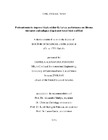Pretreatments to improve black soldier fly larvae performance on fibrous biowastes and safeguarding insect-based food and feed

Open access
Author
Date
2023Type
- Doctoral Thesis
ETH Bibliography
yes
Altmetrics
Abstract
To ensure food security and meet the rising demands of the growing population, the global food production will need to upscale. However, the current food system’s resource-intensive practices, land conversion and greenhouse gas emissions are pushing several planetary boundaries, leading to challenges such as biodiversity loss and climate change. Among the factors contributing to these environmental impacts is the production of animal sourced protein, driven by the use of several unsustainable feed ingredients (e.g., soybean and fish meal). The exploration for a more sustainable protein source is needed.
A promising alternative involves nutrient upcycling from biowastes to produce protein-rich feeds suitable for aquaculture and livestock. Larvae of the black soldier fly, Hermetia illucens L. (BSFL) can efficiently convert various biowastes into a high-protein, high-fat insect biomass (partially) substituting feeds for pig, poultry, fish and pet nutrition. The incorporation of BSFL-based feed not only reduces land utilization and greenhouse gas emissions but also enables the valorization of biowastes and byproducts. The thesis was dedicated to examining two aspects of the insect production chain, pre-processing of biowastes and post-processing of insect products to support the viability and safety of an insect-based system.
The first part of the thesis addressed BSFL’s challenges with low-value biowastes high in lignocellulosic fibers, resulting in poor development, marked by reduced bioconversion efficiency and longer developmental times. Lignocellulosic fibers, composed of lignin, cellulose, and hemicellulose, hinder microbial and larval degradation. Therefore, this thesis investigated biowaste pre-treatments to increase degradability by larvae and/or microorganisms in the biowaste or larval digestive tract. Given the limited research on biowaste pre-treatments within the BSFL context, this work evaluated the potential applicability of pretreatment methods used in other bioprocessing technologies, including physical (e.g., mechanical and thermal), chemical (e.g., alkaline and acids) and biological (e.g., bacteria and fungi) methods.
This thesis focused on evaluating the identified potential pretreatments aimed at improving BSFL performance. We investigated the use of ammonia pretreatment for lignocellulose degradation and its effect on BSFL performance. An optimal ammonia dose with 5 % and pretreatment time of three days was identified for effective fiber degradation and assessed for enhancing larval rearing. However, ammonia pretreatment for all substates decreased BSFL rearing performance metrics by more than half compared to the untreated control. Further analysis revealed that ammonia pretreatment exhibited dose-dependent toxicity towards BSFL. Therefore, ammonia pretreatment was deemed not suitable for BSFL.
Following chemical pretreatment, this thesis focused on thermal and mechanical methods, to investigate their impact on BSFL processing of fibrous biowastes. The applied thermal pretreatment resulted in either no significant improvement or decreased larval performance on all substrates, regardless of treatment duration. However, mechanical pretreatment showed promising results, demonstrating higher larvae performance. This work highlights the need to assess numerous additional pretreatments across a variety of biowastes.
Although improving BSFL development on low-value high fibrous biowastes is necessary, ensuring that the end-product is safe is equally important. Therefore, this thesis aimed to address the potential presence of pathogens in BSFL reared on various biowastes by exploring the use of an effective decontamination technology. The focus was on a non-thermal treatment technology, low-energy electron beam (LEEB) for post-processing of dried insect products. LEEB has gained interest due to its ability to reduce microbial concentrations in low moisture goods with minimal product deterioration, while potentially extending shelf-life. Given the diverse microbial communities in edible insects and insect-derived products post processing treatments are crucial for product safety. This thesis explored the application of LEEB treatment (250 keV and 12 kGy) on dried BSFL and yellow mealworm. Inoculated Escherichia coli K-12 was effectively reduced by a 4-log10 on dried BSFL. A subsequent six-month shelf-life study on naturally contaminated dried BSFL and yellow mealworm demonstrated that microbial counts in both LEEB-treated BSFL and mealworm remained lower than the control throughout the shelf-life. LEEB treatment had no impact on the peroxide value for both insects and drying treatments.
To conclude, BSFL has the potential as a viable alternative protein source, addressing the growing global demand for more sustainable animal feed solutions. The challenges posed by low-value biowastes high in lignocellulosic fibers were addressed through the investigation of biowaste pretreatments in this work. Moreover, this thesis emphasized the significance of effective decontamination technologies, with LEEB treatment proving to be a gentle and effective approach to support the safety of dried insect products. As BSFL production holds the potential for efficient waste valorization and protein-rich feed production, continued research in optimizing their rearing processes and addressing safety concerns remains imperative. Show more
Permanent link
https://doi.org/10.3929/ethz-b-000642205Publication status
publishedExternal links
Search print copy at ETH Library
Contributors
Examiner: Mathys, AlexanderExaminer: Zurbrügg, Christian
Examiner: Barragán-Fonseca, Karol
Examiner: Gasco, Laura
Publisher
ETH ZurichSubject
Hermetia illucens L.; pretreatments; Black soldier fly; waste managementOrganisational unit
09571 - Mathys, Alexander / Mathys, Alexander
Funding
861976 - SUStainable INsect CHain (EC)
More
Show all metadata
ETH Bibliography
yes
Altmetrics
